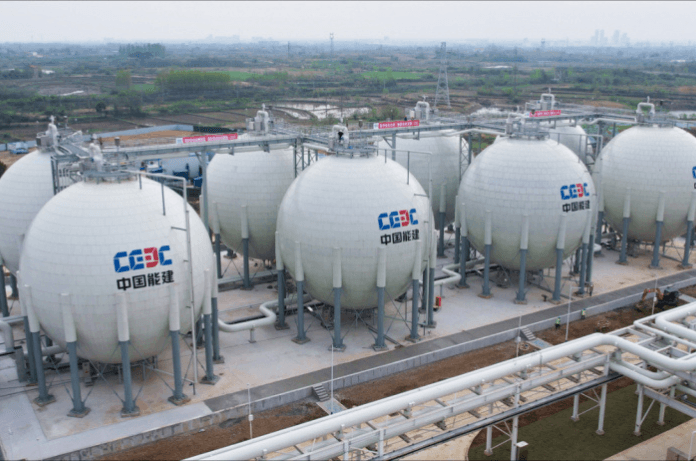Imagine if the solution to stabilizing the world’s renewable energy systems was right beneath our feet. China has just taken a groundbreaking step by unveiling the world’s first 300 MW compressed air energy storage (CAES) plant, “Nengchu-1,” located in Yingcheng, Hubei Province. This game-changing development, led by the China Energy Engineering Group Co., Ltd. (CEEC), sets a new benchmark in energy storage and green technology. It offers a powerful “Chinese solution” to the global challenge of renewable energy instability. It paves the way for a more sustainable future.
The “Nengchu-1” project is not just another energy plant; it’s a groundbreaking achievement that has set three world records in single-unit power, storage capacity, and energy conversion efficiency. Fully connected to the grid and operational, this project represents a bold stride into the future of energy storage. The plant’s ability to address the intermittency and volatility of renewable energy generation is a pivotal development for new power systems dominated by renewable sources.
The Technology Behind “Nengchu-1”
“Nengchu-1,” independently developed by CEEC in collaboration with over a hundred domestic industry partners. This mega project boasts complete independent intellectual property rights and a fully integrated industrial supply chain. This large-scale CAES solution, suitable for projects of 300 MW and above, utilizes the abundant salt cavern resources in Yunmeng and Yingcheng. Unlike traditional energy storage methods, CAES stores energy by compressing air into underground caverns. The air can then be released to generate electricity when needed.
This approach is particularly notable for its non-supplementary combustion process. The strategic and intellectual makes “Nengchu-1,” the world’s first full green and high-efficiency CAES project at such a scale. By avoiding the need for additional fuel during energy release, the plant significantly reduces its environmental footprint.
CAES stores energy by using electricity to compress air and keep it under high pressure. The system heats and expands the compressed air in a turbine to generate electricity when power is needed. This process enables the use and storage of large amounts of energy, making it a flexible way to balance supply and demand in renewable energy systems.
Environmental Impact and Efficiency
The environmental benefits of “Nengchu-1” are profound. The plant is expected to save 159,000 tons of standard coal. It will cut 411,000 tons of carbon dioxide emissions each year. This impressive reduction underscores the project’s role in supporting China’s green and low-carbon energy transition. It aligns with global efforts to combat climate change.
Wan Mingzhong, Chief Expert of CEEC, highlighted the plant’s dual function: ensuring the safe and stable operation of the power grid while facilitating the increased consumption of renewable energy. By doing so, “Nengchu-1” not only enhances grid reliability but also supports the broader integration of renewable energy sources.
Additionally, the use of salt caverns for air storage leverages natural geological formations. The salt caverns reduce the need for extensive construction and minimize environmental disruption. This method enhances the sustainability of the project, aligning with modern principles of eco-friendly industrial development.
A Vision for the Future: Nengchu-1
The success of “Nengchu-1” is a testament to China’s leadership in renewable energy technology. Song Hailiang, Chairman of CEEC, emphasized that the project provides a “Chinese solution” to the global challenge of power system instability. This achievement signals the beginning of a new era in CAES technology, with CEEC aiming to drive further innovations towards higher efficiency, lower costs, and larger-scale applications.
Looking ahead, CEEC plans to leverage the full-capacity grid connection of “Nengchu-1” to propel technological advancements in CAES. These efforts drive the global energy transition, promote a green and low-carbon future, and showcase China’s dedication to sustainable energy solutions.
This project also sets a precedent for future developments in the field. By refining the technology and expanding its scale, CEEC and its partners can contribute to the global push for sustainable energy infrastructure. The lessons learned from “Nengchu-1” will be invaluable in designing and implementing similar projects worldwide.
Conclusion
The successful grid connection of “Nengchu-1” goes beyond a technological achievement. It stands as a beacon of hope for the future. Here, renewable energy can be stored and delivered reliably whenever needed. As the world’s first 300 MW CAES plant, it not only addresses the current challenges of renewable energy systems but also paves the way for a more stable and sustainable energy landscape.
China’s “Nengchu-1” project stands as a pioneering achievement in the energy storage sector. It showcases the potential of CAES technology to revolutionize how we manage and utilize renewable energy. As the world continues to seek solutions for a greener future, “Nengchu-1” serves as a powerful example of innovation and commitment to environmental stewardship.

